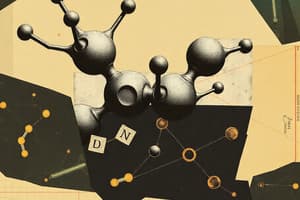Podcast
Questions and Answers
What is the process called when polymers are broken down into monomers with the addition of a water molecule?
What is the process called when polymers are broken down into monomers with the addition of a water molecule?
- Hydrolysis (correct)
- Dehydration reaction
- Glycosidic linkage
- Ester bond formation
What type of carbohydrates are composed of 100 to 1000 monosaccharides?
What type of carbohydrates are composed of 100 to 1000 monosaccharides?
- Polysaccharides (correct)
- Oligosaccharides
- Disaccharides
- Monosaccharides
What is the term for the bond that links two monosaccharides together?
What is the term for the bond that links two monosaccharides together?
- Ester bond
- Peptide bond
- Glycosidic linkage (correct)
- Hydrogen bond
What is the primary function of fats in the body?
What is the primary function of fats in the body?
What is the term for lipids that do not mix well with water?
What is the term for lipids that do not mix well with water?
What is the term for the arrangement of phospholipids in a cell membrane?
What is the term for the arrangement of phospholipids in a cell membrane?
What is the term for a type of lipid that is a major component of cell membranes?
What is the term for a type of lipid that is a major component of cell membranes?
What is the term for the process of forming polymers from monomers, which involves the loss of a water molecule?
What is the term for the process of forming polymers from monomers, which involves the loss of a water molecule?
What is the role of enzymatic proteins in regulating metabolism?
What is the role of enzymatic proteins in regulating metabolism?
What is the bond between amino acids called?
What is the bond between amino acids called?
What is the level of protein structure that refers to the sequence of amino acids?
What is the level of protein structure that refers to the sequence of amino acids?
What is the result of a change in primary structure in sickle-cell disease?
What is the result of a change in primary structure in sickle-cell disease?
What is the function of DNA?
What is the function of DNA?
What is the result of a protein consisting of two or more polypeptide chains?
What is the result of a protein consisting of two or more polypeptide chains?
Study Notes
Biological Macromolecules
- Four classes of biological molecules: carbohydrates, proteins, nucleic acids, and lipids
- Macromolecules are polymers formed from monomers through chemical reactions, facilitated by enzymes in cells
Polymers and Monomers
- Reaction connecting monomers: dehydration reaction (loss of water molecule)
- Reaction breaking down polymers: hydrolysis (addition of water molecule)
Carbohydrates
- Carbohydrate macromolecules: polysaccharides (polymers of sugar)
- Monosaccharides (sugars): glucose
- Disaccharides: two monosaccharides joined by a glycosidic linkage
- Polysaccharides: 100 to 1000 monosaccharides
- Storage polysaccharides: starch in plants (glucose monomers)
- Structural polysaccharides: cellulose
Lipids
- Mix poorly with water (hydrophobic)
- Fats:
- Constructed from glycerol and fatty acids (ester bond)
- Saturated fatty acids: no double bonds; unsaturated fatty acids: double bonds
- Major function: energy storage
- Phospholipids:
- Two fatty acids attached to glycerol
- Hydrophilic head and hydrophobic tails (phospholipid bilayer)
- Major constituent of cell membranes
- Steroids: e.g., cholesterol
Proteins
- Comprise more than 50% of cell dry mass
- Important functions: speed up reactions, defense, storage, transport, cellular communication
- Enzymatic proteins: regulate metabolism as catalysts
- Made from 20 amino acids
- Peptide bond: bond between amino acids (polypeptide)
- Amino acid monomers:
- Composed of amino group and carboxyl group
- Protein structure and function:
- Spherical and long fiber
- Levels of protein structure:
- Primary: sequence of amino acids (linear chain)
- Secondary: regions stabilized by hydrogen bonds
- Tertiary: three-dimensional shape (interactions between side chains)
- Quaternary structure: association of two or more polypeptides
Case Study: Sickle-Cell Disease
- Change in primary structure affects function
- Illustrates how a change in structure can lead to a change in function
Nucleic Acids
- Polymers made of nucleotides (monomers)
- Two types: DNA and RNA (allow gene expression)
- DNA: genetic material inherited from parents
Studying That Suits You
Use AI to generate personalized quizzes and flashcards to suit your learning preferences.
Description
This quiz covers the basics of biological macromolecules, including carbohydrates, proteins, nucleic acids, and lipids. Learn about the formation and breakdown of these molecules through dehydration and hydrolysis reactions.




